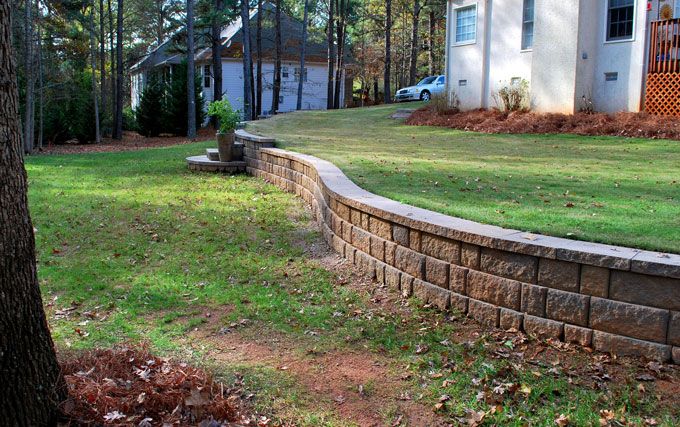
Retaining Wall Options for Your Home or Business
If you’re planning new construction, battling eroding hillsides or unusual elevation changes, a retaining wall may be the perfect solution. Retaining walls can add level areas, tame eroding slopes, change the flow of runoff water from heavy rains and add a strong landscape design element at the same time. Free standing walls for patios and fire pit areas are becoming much more popular but still require installer knowledge to build them correctly to insure long life without settling issues. Engineering requirements, knowing the best wall system for the job, and having the heavy equipment necessary to move soil are all important components to building a retaining wall correctly. Let the experts at Landscape Innovations guide you through the entire design and build process.
Things to Consider
Consumers usually want a certain look but do not consider or understand the engineering side of building a wall. Retaining walls fail because of poor design and lack of proper engineering requirements. Every “gravity wall” system ( a wall that relies on its own weight to hold back the forces of the soil pushing on it ) is designed to a particular load and height. Stackable wall block systems are available from numerous manufacturers but the popular ones in our area are Pavestone and Belgard because they are made locally and shipping costs are low. These wall blocks are available in 4”, 6”, and 8” tall blocks with varying widths and many color combinations. Wall systems are specifically designed for certain tasks. The largest blocks are built to hold back soil up to 4’ high without further reinforcement. Beyond 4’, “by Georgia code” a retaining wall needs to be permitted. By getting a permit, the wall cost will go up but you then have an engineer approving the design and insuring best building practices. The slope toward the top of a retaining wall should also be considered as part of the design. A steep downhill slope toward a “Segmental” retaining wall places a much higher load on the wall than a flat space above it. Terracing ( building multiple walls on one hill side and creating numerous flat areas) must also follow engineering rules. If built improperly, a terraced wall system will rely on the footing of the lowest wall for the stability of all the walls above it. Let me put all this into perspective. If you have a wall built that fails, it will cost more than double the cost of just doing it right to start with. You will be paying to remove the failed wall and build it correctly.
Steps of the Build
Placement is usually determined by a combination of the lay of the land and the requirements of the customer. We will choose the location, height and design based these and other site requirements like property line setbacks and drainage issues. Creating a proper drainage flow is probably the single most important component of the process. Hydraulic pressure is usually the reason a wall fails.
We excavate the soil down to the lowest point of the wall then compact the footing material and begin building the wall. We place a drain tile pipe at the base of the wall on the dirt side that will give the excess water a place to exit, then we back fill the first 1’ of width or more (based on engineering requirements) with drainage gravel (5/7 stone). We also place filter fabric between the soil and gravel to keep fine sediment from the soil from eventually filling the gravel spaces.
Back-fill for a retaining wall should never be placed without proper compaction. Excessive settling can occur during the first few heavy rains and bulge out or knock down a wall. We compact the soil every 4-8” of back fill and use heavy duty “geo-textile” netting when necessary to insure the wall will last.
As the height of the wall is reached, we fold the fabric back toward the wall, and cover the fabric with 6-12” of soil and shape it to route the runoff water away from the wall wherever possible. NEVER build a wall where the runoff drains into the soil or gravel directly behind the wall. This will always lead to eventual failure.
Adding a retaining wall is the perfect way to polish off your landscape this year. Our landscape experts can work with you to plan out your drainage, plants, sod & lighting, needs. The rest is up to you! Contact us today to plan a complimentary estimate on your hardscaping design. We’re right here in Fayetteville and have been serving the area for over 27 years.
Posted on behalf of
215 Rebecca Ct
Fayetteville, GA 30215
Phone: (770) 616-3194
Burt@landscapeinn.com
Monday - Friday 8:00 AM – 5:00 PM
